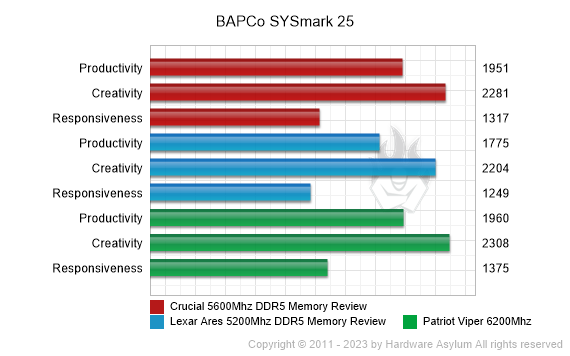Crucial 5600Mhz DDR5 Memory Review
Author: Dennis GarciaSystem Configuration and Benchmarks
DDR5 is still an extremely new memory platform and many companies are still feeling out what separates a good memory module from one that works but, is nothing special. The first Crucial DDR5 release was limited to 4800Mhz, it would overclock to 5200Mhz without too much trouble. Later we were able to review samples of that module from Lexar at the 5200Mhz speed with identical performance.
What is interesting is that we have also reviewed DDR5 modules from Patriot that were not only available at the LGA1700 Processor launch but, ran exceptionally well at the advertised 6200Mhz speeds. It doesn’t take much to realize that the Crucial memory modules fall into the “works but, is nothing special” category. At least from the standpoint of performance and gaming.
With that being said let’s see how they stack up.
EVGA Z690 Dark – Z690 Chipset
Intel Core i7 12700k (3.2Ghz) Sixteen Core 12+12 32KB L2 Cache 9+9 x 1.25MB L3 Cache 25MB
Cooler Master MasterLiquid PL360 Flux
1x nVidia RTX 2080 Super
Crucial BX500 960GB SSD
Thermaltake Toughpower Grand 1050 Watt PSU
Windows 11 Pro 64bit
Memory Tested
2x Crucial PC5-5600 16GB DDR5 (46-45-45-90)
Reference
2x Crucial PC5-4800 16GB DDR5 (40-39-39-76)
2x Patriot Viper Venom PC5-6200 DDR5 32GB (40-40-40-77)



Sandra is a software collection of synthetic benchmarks that will give us a basic idea as to what a system is capable of. It should be noted that SiSoft numbers change depending on what hardware is being tested. These were recorded using Sandra Professional Version 31.115.2021.12

AIDA64 Extreme Edition is a streamlined diagnostic and benchmarking software package designed to assist with overclocking and general system tuning. The package also contains modules to assess the performance of the processor, system memory, and disk drives in addition to normal stuff like stress testing and troubleshooting.


Unigine is a synthetic benchmark much like 3DMark Vantage, but supports the newest of DirectX 11 technologies. The benchmark comes with lots of heavy tessellation and soft shadows to work the more flexible shaders found on DirectX 11 graphic cards. This makes this benchmark ideal for seeing exactly what a best case scenario might look like for a DirectX 11 capable GPU.
Benchmark Settings
HWBot Benchmark
DirectX 11 Presets
DirectX 9 Presets

SYSmark 25 is an application-based benchmark that reflects usage patterns of business users in the areas of Productivity, Creativity and Responsiveness. The new Productivity Scenario has updated workloads and applications geared towards office centric user activities. The new Creativity Scenario features updated workloads and applications geared toward media-centric user activities. The new Responsiveness Scenario models ‘pain points’ in the user experience. These common activities that include: application launches, file launches, web browsing with multiple tabs, multi-tasking, and background application installation.


PCMark 10 is an overall system benchmark to measure and compare PC performance using real-world tasks and applications. Similar to 3DMark this new version tests the entire system as a whole using applications that reflect typical PC use in the home and at the office. This approach ensures that PCMark measures the things that matter, highlighting performance differences that will be apparent to end users and consumers.

Our memory benchmarks comprise a good cross section of performance. Sandra is testing overall bandwidth, which is typically a product of frequency and timings to a lesser degree. AIDA can reaffirm this though adds the latency metric showing and speed and timings can change how fast the memory can react.
The practical benchmarks show how the memory responds to real world situations. Unigine illustrates how little memory plays in overall DX11 video performance and quite the opposite with DX9. BAPCo SYSMark might be the best at showing the difference a quality memory module can make depending on the workload.

